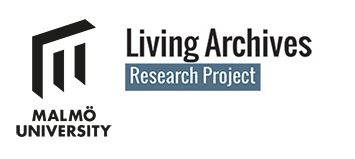People of African descent have been represented in the West as an ‘other’ – a foreign presence. The stereotypes that have been created around this foreign presence, and how these stereotypes are replicated and reproduced over time, are at the centre of Dr Temi Odumosu’s research.
Dr Temi Odumosu is an art historian, a creative educator, and since a few months back post-doctoral researcher in the Living Archives research project. For a brief introduction to her work and approach, see the video embedded below (or here on YouTube). A text summary of the video is included below.
Video production: Jacek Smolicki.
Dr Temi Odumosu was born and raised in London, and she describes herself as an art historian and a creative educator.
– An art historian, for me, encapsulates all of the things that I love: writing, teaching, drilling archives, interrogating history, and telling stories. I also describe myself as a creative educator because I am passionate about sharing knowledge with people and helping them to see things in new ways.
For the last ten years, Odumosu’s research has been focused on the visual representation of people with African descent in popular visual culture. These visual representations have primarily been produced in Europe and America and to a lesser extent in the West Indies.
– I’m really an 18th century scholar. I’ve spent most of my time looking at images produced during that period, which was the height of the transatlantic slave trade. It was a period where the issue of colonization, this new foreign influence, became a hot topic and was therefore represented in the kind of images the people made.
Odumosu’s PhD at the University of Cambridge explores the representation of black characters in satirical and comic prints during the 18th and early 19th centuries. It looked at the ways in which they became symbolic of all of the foreign, external influences, working their way through British society at the time.
The main themes in Odumosu’s research have to do with race, identity, and representation.
– I’m interested in how people of African descent, and other ethnic minority communities, have been represented in the West as an ‘other’ – a foreign presence. Then I’m interested in the ways in which stereotypes are created around their presences, and then replicated and reproduced over time.
Odumosu says that for the most part, the images that we consumed in the early 18th century haven’t changed in the present day:
– This idea of black people’s bodies being a stage upon which desires and fantasies are projected; ideas of the savage and the exotic, and bodies connected to things that are about pleasure and luxury and excess – those things are still the same. They haven’t changed. I’m fascinated about the way in which we live with a very strong visual memory that has come from the past, and that just doesn’t seem to have adapted with time.
She continues:
– Another really interesting thing that has stood out to me during my process of interrogating the archive is just how much that is hidden there. There are so many stories that are yet to be told. I am fascinated by this process of actually going into an archive and taking out new things, and what that means to me as a researcher, but also to the development of knowledge itself.
Temi Odumosu is also interested in what happens to researchers in that process, and also the kinds of researchers that go into archives and how that shifts and changes the way stories are told. That is, how knowledge is constructed.
– For me, academia is filled with people telling stories from a very limited point a view. I’m interested in expanding that view, bringing in different and diverse voices – thinkers, educators, artists – people who see the world in a different kind of way.
Odumosu works with a wide body of knowledge – including books, artifacts, films, and images in different media – that explore the representation of people of African descent, and that also look at the way in which black aesthetics can be transformed and changed.
– Here at Living Archives, I think I have two roles. One is just to bring different kinds of archives into conversation with the kinds of technology and theories that our group is developing. The other is to think about the ways in which we can bring these images and these presences into public space. How can we use this knowledge and this data and bring it into conversation with the archives of people out there who perhaps don’t know it very well, or perhaps haven’t come into contact with these kinds of images. Providing an alternative perspective, another point of view, another way of thinking about representation – that’s my goal here at Living Archives.
Read more
– Dr Odumosu’s website – temiodumosu.com
– Contact



